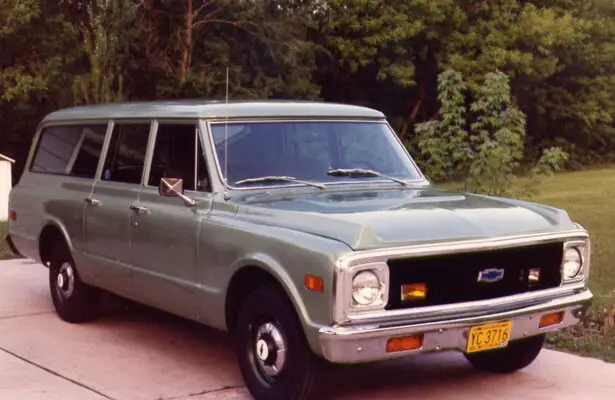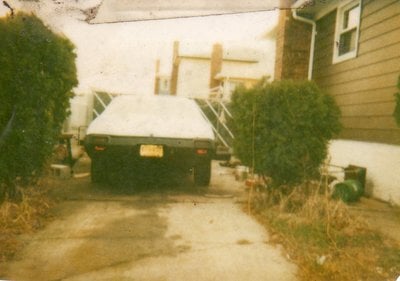Why You Don't Box Rear Upper Control Arms
- Thread starter pontiacgp
- Start date
You are using an out of date browser. It may not display this or other websites correctly.
You should upgrade or use an alternative browser.
You should upgrade or use an alternative browser.
- Status
- Not open for further replies.
Greetings Guys; Thank you pontiacgp for posting that under side picture of a GM (swing?) arm set up. I believe it was Junior Johnson that first used the 67 Gm truck arms on a Ford? I had owned a 72 Suburban for 15 years (76-91) with that chassis and ended up parting it out as I couldn't sell it. Reason I quit driving it was the control (swing) arms were so rusted that they were near braking point. And around here a good arm was impossible to find. Had I realized at the time I could of got new ones from some NASCAR supplier! After 19 winters (non galvanized) second body was gone. I had done an off frame resto & put a Wyoming body on my frame, a lot of work for very little reward.
Anyway back to triangulated four links, you guys have excellent incite into the geometry & function of these systems. You all opened my eyes with more info than my LMG (late middle aged) brain can retain, so to make room my brain pushed out more hair. Now I know why the guy from Global West did NOT recommend upper arms for me back in 2003 when I purchased the lower arms. But he did say that they had the best street (lower) arm on the market. Why because of the spherical rod end at the front and a delrin - aluminum ( Del-A-Lum) greaseable bushing at the rear. This design has worked well for me as I street (road) drive a lot and these arms conform to the road very well. So back when I only had 450-460 Lbs Ft of torque and newer 220 (UTQG) tires the car hooked up OK on the street. Thank you all Bob Jr.
Anyway back to triangulated four links, you guys have excellent incite into the geometry & function of these systems. You all opened my eyes with more info than my LMG (late middle aged) brain can retain, so to make room my brain pushed out more hair. Now I know why the guy from Global West did NOT recommend upper arms for me back in 2003 when I purchased the lower arms. But he did say that they had the best street (lower) arm on the market. Why because of the spherical rod end at the front and a delrin - aluminum ( Del-A-Lum) greaseable bushing at the rear. This design has worked well for me as I street (road) drive a lot and these arms conform to the road very well. So back when I only had 450-460 Lbs Ft of torque and newer 220 (UTQG) tires the car hooked up OK on the street. Thank you all Bob Jr.
Attachments
Eh, I will take a shot at this. Ever look at the stock bushing? the tube in the center has serrations which, when you tighten the bolt, hold it to the frame and axle. The rubber (or whatever the black stuff is) rotate around the center sleeve. As far as the range of travel for the axle, the control arms locate it consistently. Perpendicular and square. For he driving I do (which is mostly in a straight line) boxed upper and lower factory control arms with polyurethane bushings work just fine. I don't do a lot of tight radius turns so I have no experience with most of what the OP describes.I do have experience with my set up (second G I have done this way) and other than chatter from the locker when I do turn, I notice no ill effects. And I run a factory sway bar in the rear. Launches are relatively stable and straight. I don't use regular street tires on the rear axle, just slicks and drag radials. Just sharing my experience.
Slicks and Drag radials (depending on which style Drag radials) are the reason you may not notice any affects of the boxed uppers. Their soft side walls can cushion the snap back. The snap back occurs when you put the car in a loaded side roll. Meaning the car tries to shift its weight on outside tire of the turn your doing. The 4 link is trying to keep the axle flat on the ground but, with no flex in the arms, you'll have the inside tire lifting off the ground for a while. Then one of two things will happen, either the bolts will elongate or the frame brackets will start pulling away from its welds on the frame. If you braced the 4 frame brackets, then only the bolts will elongate. Neither option is ok.
I've seen it happen on A-bodies, B-bodies, G bodies and Fox bodied Fords. A guy boxed the uppers and lowers on his '69 GTO. He used L60 tires and liked to go fast around corners. Then one day at the track he put slicks on it and pulled the front tire on launch on his first pass. the second pass he ripped the driver side upper bracket off the frame. The bolt holes were egg shaped. Just think, the early A bodies were way stronger and better made than our G bodies. That's why the 80s cars are more prone to this.
T
I've seen it happen on A-bodies, B-bodies, G bodies and Fox bodied Fords. A guy boxed the uppers and lowers on his '69 GTO. He used L60 tires and liked to go fast around corners. Then one day at the track he put slicks on it and pulled the front tire on launch on his first pass. the second pass he ripped the driver side upper bracket off the frame. The bolt holes were egg shaped. Just think, the early A bodies were way stronger and better made than our G bodies. That's why the 80s cars are more prone to this.
T
I hear what you are saying. Oversteer (i thought) was when the rear wheels are spinning faster and allow a sideward drift that is countered by steering in the direction you wish to travel. I don't drive that way, ever. I'm still trying to digest that the popular conception here that factory control arms flex as a part of their design. Flex creates fatigue, and fatigue creates cracks. I cannot get my head around flexing control arms, The bushings, (factory rubber) sure. Body roll is controlled somewhat by the factory sway bar(s). Which also deform the factory bushings at the ends of the front bar through use. (and any replacement style bushings) I must be doing something the rest of you aren't.
It is not a popular conception that the upper arms are manufactured to twist when binding. It's a fact. When the rear end is lifted on one side the ears on the rear end changes their angle so the uppers has to twist to relieve the pressure on the bolt and bushing. It's confusing to me why anyone who wants to upgrade their suspension do not research the subject so their money goes to improve the suspension instead of making it worse.
I used to think that way when I was first learning suspension geometry. I was scratching my head when I saw the hop stop bars work the first time. By just raising the angle of the UCAs above the differential would cause the rear of the car to raise during launch. I'm still kinda mystified by it and I know how it works now. Even though I never boxed a rear control arm, I knew many that did and their cars rode stiff and they didn't have hard springs like I had. Funny thing was my friend's '69 GTO still squatted on launch. Not as much as it was before he boxed the control arms, when he had just the traction bars. (yep, he had coil spring traction bars!) It had the power to do 11s. He just couldn't get it to the ground.
I always like to think outside the box and against the norm ever since, I had my '71 4 door Cutlass that could out launch most of my buddy's cars and all I was did was use '68 Chevy truck springs and 90/10 shocks in the front. No rear sway bar! It would shift the weight to the rear so quick. I once put a penny on top of the dash above the radio while a friend was in the car and when I hit the gas, the penny leaped to the back seat! Technically, I eliminated the rear from squatting on launch, only movement was the front lifting up level to the high rear. The front was raising from about a 2 inch lower than stock resting height.
I always like to think outside the box and against the norm ever since, I had my '71 4 door Cutlass that could out launch most of my buddy's cars and all I was did was use '68 Chevy truck springs and 90/10 shocks in the front. No rear sway bar! It would shift the weight to the rear so quick. I once put a penny on top of the dash above the radio while a friend was in the car and when I hit the gas, the penny leaped to the back seat! Technically, I eliminated the rear from squatting on launch, only movement was the front lifting up level to the high rear. The front was raising from about a 2 inch lower than stock resting height.
Attachments
So what you are saying is the upper control arm with the three longitudinal 90 degree bends in it per side (six in total)flex/twist as part of the design. If it ever warms up here I am going to have a look at the suspension in my totally stock Cutlass and see if I can witness what it is you are describing. I am having a tough time with this. I may even take some pictures.pontiacgp said:It is not a popular conception that the upper arms are manufactured to twist when binding. It's a fact. When the rear end is lifted on one side the ears on the rear end changes their angle so the uppers has to twist to relieve the pressure on the bolt and bushing. It's confusing to me why anyone who wants to upgrade their suspension do not research the subject so their money goes to improve the suspension instead of making it worse.
- Status
- Not open for further replies.
Similar threads
- Replies
- 5
- Views
- 221
- Replies
- 0
- Views
- 133
- Replies
- 0
- Views
- 158
GBodyForum is a participant in the Amazon Services LLC Associates Program, an affiliate advertising program designed to provide a means for sites to earn advertising fees by advertising and linking to amazon.com. Amazon, the Amazon logo, AmazonSupply, and the AmazonSupply logo are trademarks of Amazon.com, Inc. or its affiliates.






